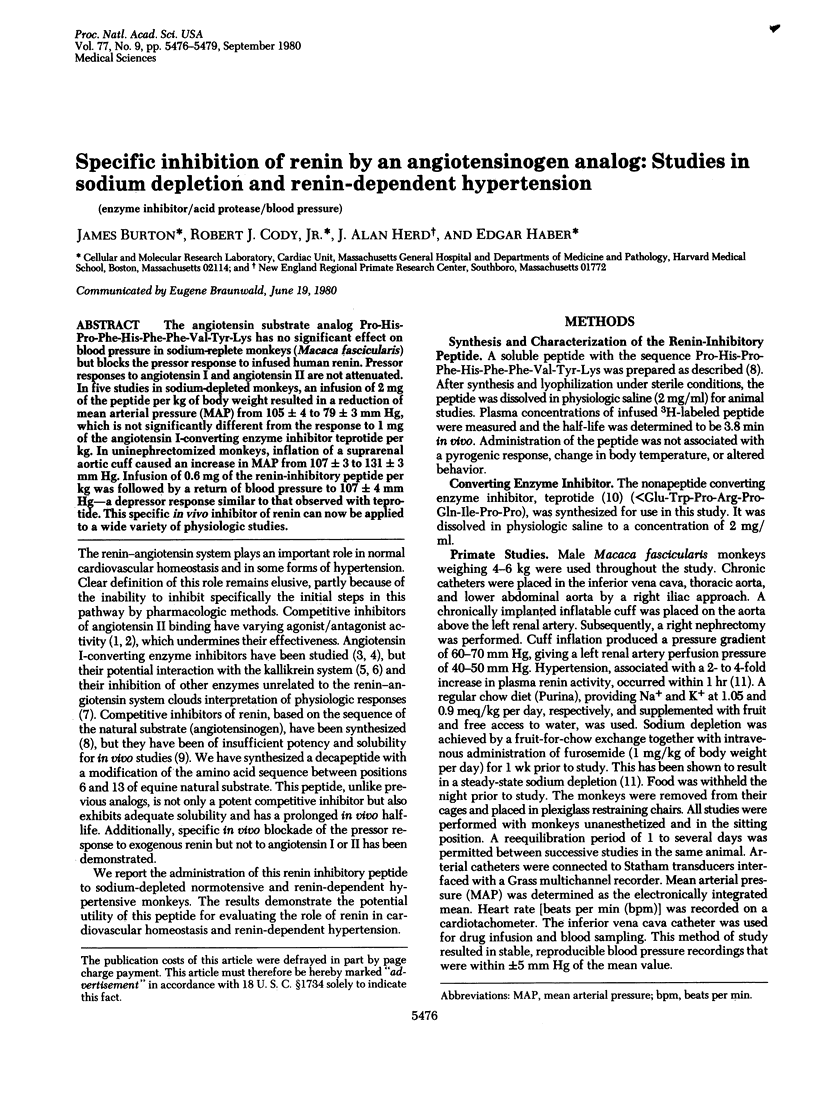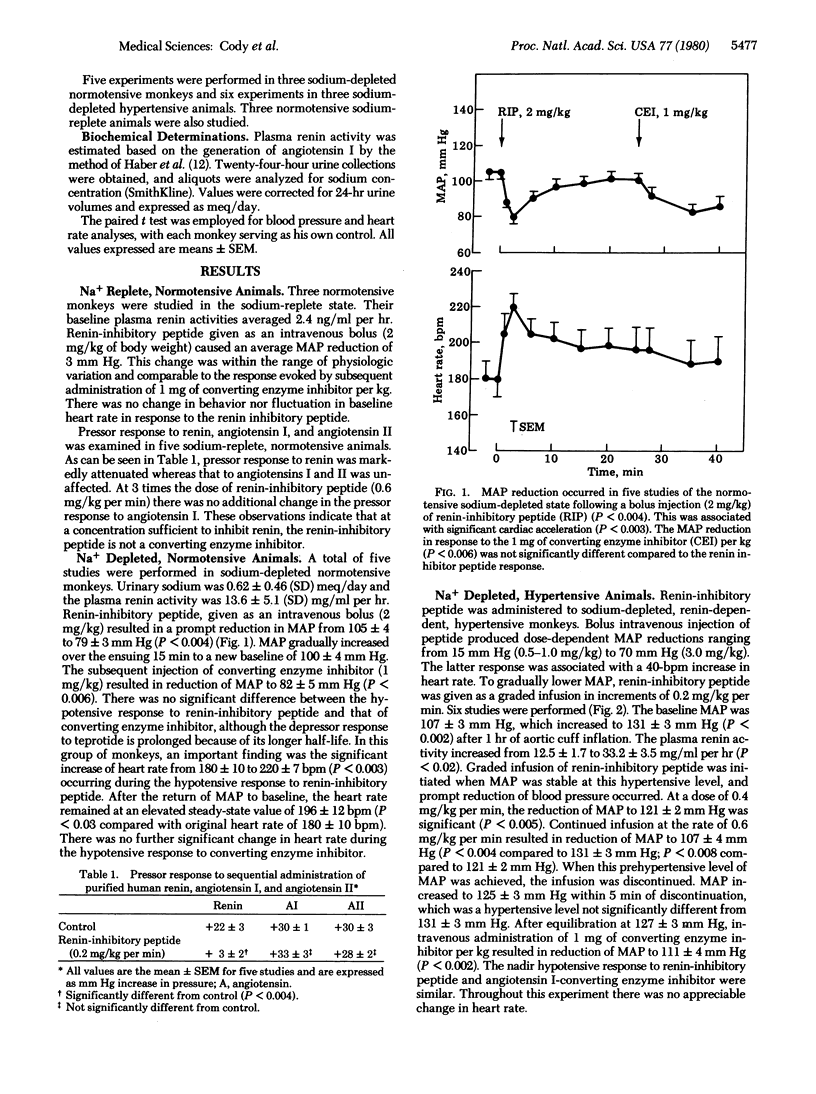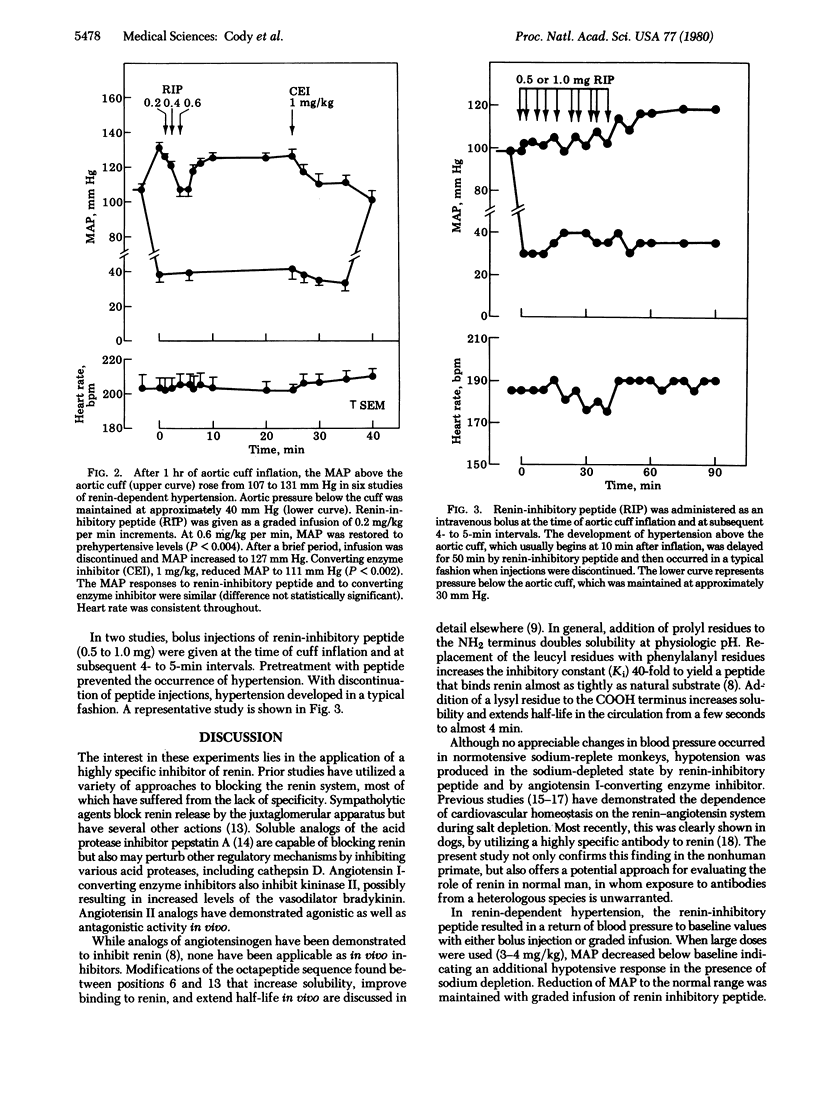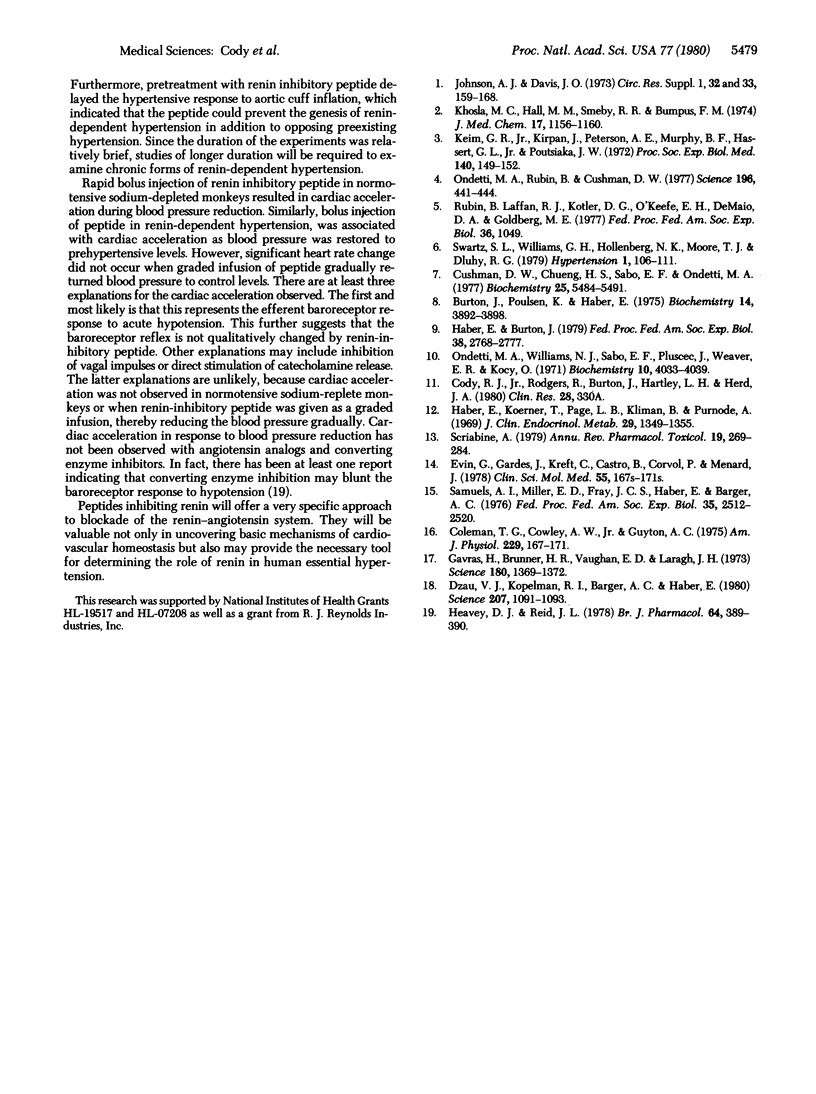Abstract
The angiotensin substrate analog Pro-His-Pro-Phe-His-Phe-Phe-Val-Tyr-Lys has no significant effect on blood pressure in sodium-replete monkeys (Macaca fascicularis) but blocks the pressor response to infused human renin. Pressor responses to angiotensin I and angiotensin II are not attenuated. In five studies in sodium-depleted monkeys, an infusion of 2 mg of the peptide per kg of body weight resulted in a reduction of mean arterial pressure (MAP) from 105 +/- 4 to 79 +/- 3 mm Hg, which is not significantly different from the response to 1 mg of the angiotensin I-converting enzyme inhibitor teprotide per kg. In uninephrectomized monkeys, inflation of a suprarenal aortic cuff caused an increase in MAP from 107 +/- 3 to 131 +/- 3 mm Hg. Infusion of 0.6 mg of the renin-inhibitory peptide per kg was followed by a return of blood pressure to 107 +/- 4 mm Hg--a depressor response similar to that observed with teprotide. This specific in vivo inhibitor of renin can now be applied to a wide variety of physiologic studies.
Full text
PDF



Selected References
These references are in PubMed. This may not be the complete list of references from this article.
- Burton J., Poulsen K., Haber E. Competitive inhibitors of renin. Inhibitors effective at physiological pH. Biochemistry. 1975 Aug 26;14(17):3892–3898. doi: 10.1021/bi00688a024. [DOI] [PubMed] [Google Scholar]
- Coleman T. G., Cowley A. W., Jr, Guyton A. C. Angiotensin and the hemodynamics of chronic salt deprivation. Am J Physiol. 1975 Jul;229(1):167–171. doi: 10.1152/ajplegacy.1975.229.1.167. [DOI] [PubMed] [Google Scholar]
- Cushman D. W., Cheung H. S., Sabo E. F., Ondetti M. A. Design of potent competitive inhibitors of angiotensin-converting enzyme. Carboxyalkanoyl and mercaptoalkanoyl amino acids. Biochemistry. 1977 Dec 13;16(25):5484–5491. doi: 10.1021/bi00644a014. [DOI] [PubMed] [Google Scholar]
- Dzau V. J., Kopelman R. I., Barger A. C., Haber E. Renin-specific antibody for study of cardiovascular homeostasis. Science. 1980 Mar 7;207(4435):1091–1093. doi: 10.1126/science.6986653. [DOI] [PubMed] [Google Scholar]
- Evin G., Gardes J., Kreft C., Castro B., Corvol P., Menard J. Soluble pepstatins: a new approach to blockade in vivo of the renin-angiotensin system. Clin Sci Mol Med Suppl. 1978 Dec;4:167s–169s. [PubMed] [Google Scholar]
- Gavras H., Brunner H. B., Vaughan E. D., Laragh J. H. Angiotensin-sodium interaction in blood pressure maintenance of renal hypertensive and normotensive rats. Science. 1973 Jun 29;180(4093):1369–1371. doi: 10.1126/science.180.4093.1369. [DOI] [PubMed] [Google Scholar]
- Haber E., Burton J. Inhibitors of renin and their utility in physiologic studies. Fed Proc. 1979 Dec;38(13):2768–2773. [PubMed] [Google Scholar]
- Haber E., Koerner T., Page L. B., Kliman B., Purnode A. Application of a radioimmunoassay for angiotensin I to the physiologic measurements of plasma renin activity in normal human subjects. J Clin Endocrinol Metab. 1969 Oct;29(10):1349–1355. doi: 10.1210/jcem-29-10-1349. [DOI] [PubMed] [Google Scholar]
- Keim G. R., Jr, Kirpan J., Peterson A. E., Murphy B. F., Hassert G. L., Jr, Poutsiaka J. W. Inhibition of angiotensin I-initiated hemodynamic changes in anesthetized dogs by a synthetic nonapeptide. Proc Soc Exp Biol Med. 1972 May;140(1):149–152. doi: 10.3181/00379727-140-36413. [DOI] [PubMed] [Google Scholar]
- Khosla M. C., Hall M. M., Smeby R. R., Bumpus F. M. Agonist and antagonist relationships in 1- and 8-substituted analogs of angiotensin II. J Med Chem. 1974 Nov;17(11):1156–1160. doi: 10.1021/jm00257a006. [DOI] [PubMed] [Google Scholar]
- Ondetti M. A., Rubin B., Cushman D. W. Design of specific inhibitors of angiotensin-converting enzyme: new class of orally active antihypertensive agents. Science. 1977 Apr 22;196(4288):441–444. doi: 10.1126/science.191908. [DOI] [PubMed] [Google Scholar]
- Ondetti M. A., Williams N. J., Sabo E. F., Pluscec J., Weaver E. R., Kocy O. Angiotensin-converting enzyme inhibitors from the venom of Bothrops jararaca. Isolation, elucidation of structure, and synthesis. Biochemistry. 1971 Oct 26;10(22):4033–4039. doi: 10.1021/bi00798a004. [DOI] [PubMed] [Google Scholar]
- Samuels A. I., Miller E. D., Jr, Fray J. C., Haber E., Barger A. C. Renin--angiotensin antagonists and the regulation of blood pressure. Fed Proc. 1976 Nov;35(13):2512–2520. [PubMed] [Google Scholar]
- Scriabine A. Beta-adrenoceptor blocking drugs in hypertension. Annu Rev Pharmacol Toxicol. 1979;19:269–284. doi: 10.1146/annurev.pa.19.040179.001413. [DOI] [PubMed] [Google Scholar]
- Swartz S. L., Williams G. H., Hollenberg N. K., Moore T. J., Dluhy R. G. Converting enzyme inhibition in essential hypertension: the hypotensive response does not reflect only reduced angiotensin II formation. Hypertension. 1979 Mar-Apr;1(2):106–111. doi: 10.1161/01.hyp.1.2.106. [DOI] [PubMed] [Google Scholar]


